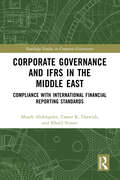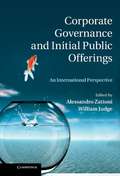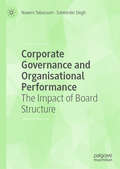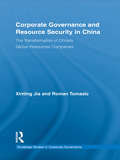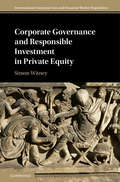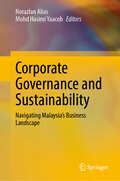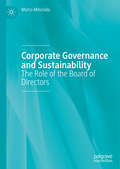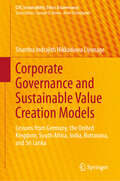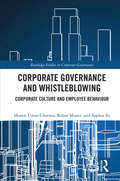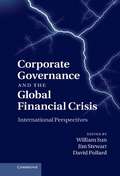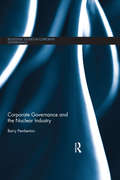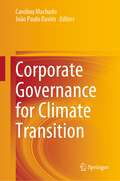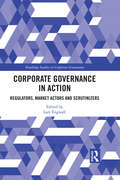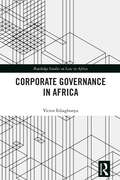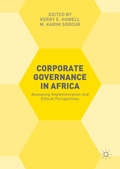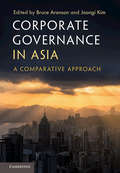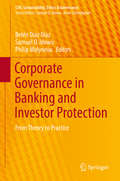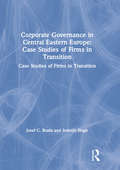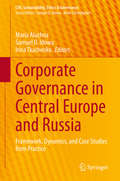- Table View
- List View
Corporate Governance and IFRS in the Middle East: Compliance with International Financial Reporting Standards (Routledge Studies in Corporate Governance)
by Tamer K. Darwish Muath Abdelqader Khalil NimerThe rapid globalization of capital markets has increased attention toward examining the quality of the disclosure practices implemented by companies, as internationalization and globalization are the most important motives of the harmonization of financial statements preparation and presentation. Given the expansion of trade and the openness to foreign capital markets, investment decisions became not limited only for local users, but also international users may need to access the financial information. The issuance of International Financial Reporting Standards (IFRS) to be used throughout the world aims to improve the comparability and understandability of financial statements, and hence, to enhance investment decisions through helping investors across the borders to invest in multinational companies. Although fluid and under-developed institutional arrangements remain central features of emerging markets, ensuring effective corporate governance mechanisms would indeed support companies in complying with IFRS – the latter imposes a challenge for companies operating in emerging markets. This book evaluates the differences in the level of compliance with IFRS across the GCC states, exploring the impact of corporate governance on the level of compliance with IFRS and presenting an empirical analysis of companies across the GCC. It makes an important contribution by providing a detailed empirical analysis of the interplay between corporate governance and IFRS in emerging market setting and highlights the way for future research. It will provide international business, management, and accounting and finance students and senior practitioners with a completely new and updated guide to the work in the field of corporate governance and IFRS compliance in emerging markets.
Corporate Governance and Initial Public Offerings
by Alessandro Zattoni William Judge"Initial Public Offerings (IPOs) are unique economic and governance events as privately held firms issue common stock or shares to the public for the first time. The governance issues surrounding IPOs are relatively unexamined compared to more established, and usually larger, firms. As such, they provide a unique context to study corporate governance and its development around the world. Based on a collaborative international research project, this book analyses the corporate governance of IPOs in twenty-one countries, each of which is characterized by different governance environments and different levels of IPO activity. The end result is a broad and deep assessment of governance practices and IPO activity for an array of economies that represent roughly 80 percent of the global economy. These chapters collectively provide new insights into what a global theory of corporate governance might look like and offer guidance to policy makers and academics regarding national governance configurations"--
Corporate Governance and Leadership: The Board as the Nexus of Leadership-in-Governance (Elements in Corporate Governance)
by Brad Jackson Chris Noonan Susan Watson Monique Cikaliuk Ljiljana ErakovićThis Element deals with leadership and governance of corporations from the point of view of the board. We expand our understanding of board leadership by focusing on the modern company as a legal person comprised of a capital fund and the relationships among directors, shareholders, management and stakeholders. We propose a model which integrates insights from the fields of leadership and corporate governance and establishes a theoretical link illustrated by empirical findings in three intersections: team leadership on the board, the chair's leadership of the board, and strategic leadership by the board. We maintain this integrative model provides a powerful means to further an understanding of the board as the nexus of leadership and governance. We close this Element by identifying the new research directions that our integrative model opens up. We also identify the implications for practice for those who either serve on boards or provide support to them.
Corporate Governance and Organisational Performance: The Impact of Board Structure
by Naeem Tabassum Satwinder SinghEstablishing a corporate governance strategy that promotes the efficient use of organisational resources is instrumental in the economic growth of a country, as well as the successful management of firms. This book reviews existing literature and identifies board structural features as key variables of an effective corporate governance system, establishing a multi-theoretical model that links Board structural characteristics with firm performance. It then, using a comprehensive empirical study of 265 companies listed on the Karachi Stock exchange, tests this conceptual model. This research serves as a significant milestone, reflecting the socio-economic setting of emerging economies, and highlighting the need for the corporate sector in emerging markets to move away from a 'tick-box' culture. It argues that the sector needs to implement corporate governance as a tool to mitigate business risks; appoint and empower non-executive directors to achieve an effective monitoring of management; and establish their own ethical and governance principles, applicable to the Board of Directors.Based on an extensive data base, collected painstakingly over five years, this book offers new insights and conceptual framework for further research in this area. Given the breadth and width of the research, it is a useful source of future reference for students, researchers and policy makers.
Corporate Governance and Resource Security in China: The Transformation of China's Global Resources Companies (Routledge Studies in Corporate Governance #Vol. 4)
by Xinting Jia Roman TomasicCorporate governance has become a household term and investors across the world are demanding more transparency and accountability from controllers of listed corporations. The current resources boom that has been driven by soaring demand from China has brought China’s listed resources companies into focus. Some of these companies are beginning to be known internationally, such as Sinopec, PetroChina, CNOOC (in the oil industry) and CHALCO (aluminium); but their governance structures are often not well known. This book explores the corporate governance of these listed companies. Compared with the governance of global companies, such as BHP Billiton, Rio Tinto, Shell, Shevron, the governance of China’s resources companies has special characteristics. While the authors focus is on the governance of resources companies in China, this book also tackles contemporary issues of resource security and environmental change which are closely related to the depletion of the world’s natural resources. Case studies of other international resources giants such as BHP Billiton, Rio Tinto, Shell and Chevron are provided to enhance our understanding of the differences that exist between them and Chinese resources companies. This book will be of interest to the business community and to those readers who are interested in China and its governance related issues.
Corporate Governance and Responsible Investment in Private Equity (International Corporate Law and Financial Market Regulation)
by Simon WitneyPrivate equity-backed companies are ubiquitous and economically significant. Consequently, the corporate governance of these companies matters to all of us, and – not surprisingly – is coming under increasing scrutiny. Simon Witney, a practicing private equity lawyer, positions private equity portfolio companies within existing academic theory and examines the laws that apply to them in the UK. He analyses the actual governance frameworks that are put in place and identifies problems created by the legal rules – as well as the market's solutions to them. This book not only explains why these governance mechanisms are established, but also what they are expected to achieve. Witney suggests that private equity owners have both the incentives and the capability to focus on responsible investment practices. Good governance, he argues, is a critical success factor for the private equity industry.
Corporate Governance and Risk Management in Financial Institutions: An International Comparison Between Brazil and Germany (Contributions To Management Science)
by Robert C. GerickeThis book presents an overview of corporate governance and risk management, analyzing their interdependence and particularly their relevance in banking. It discusses current trends in corporate governance, such as stakeholder management, financial performance and the cost of equity, compensation schemes, board structures and shareholder activism. Further, it reviews some of the most important regulatory changes introduced since the latest financial crisis and highlights their impact on the annual reports of the banks under analysis. Lastly, the book assesses and compares major banks in Brazil and Germany with special emphasis on the aspects mentioned above, revealing surprising similarities between the banking systems of these otherwise disparate countries.
Corporate Governance and Sustainability: Challenges for Theory and Practice (Routledge Contemporary Corporate Governance)
by Suzanne Benn Dexter DunphyIn recent years, as corporations and governments have increasingly been confronted with managing the expectations of a society newly alerted to the social and environmental risks of economic development, recognition is dawning that achieving a sustainable world is dependent upon the democratic management and equitable distribution of these risks for now, and for the future. This book, the first to explore the themes of corporate governance and sustainability, argues that a better system of governance on a number of levels holds the key. Contributed to and edited by a distinguished international team, this book recognizes the complex and contested nature of both sustainability and governance, and that these key concepts have been redefined considerably over time. As sustainability poses new and major challenges for the theory and practice of corporate governance, this book, ideal for postgraduate students of business and management, identifies and addresses these challenges.
Corporate Governance and Sustainability: Navigating Malaysia's Business Landscape
by Norazlan Alias Mohd Hasimi YaacobThis book presents a comprehensive exploration of contemporary issues in corporate governance and sustainability within the Malaysian context. Authored by experienced scholars and practitioners, each chapter delves into critical aspects shaping the landscape of business ethics, digital transformation, and societal responsibility. Beginning with an examination of role of digital transformation in driving sustainable innovation for Micro, Small, and Medium-Sized Enterprises (MSMEs), the volume goes on to explore the transformative potential and challenges of digital technologies on governance, sustainability, and taxation. It further highlights the significance of environmental, social, and governance (ESG) factors in measuring the sustainability and societal impact of businesses. Through insightful discussions on directorial responsibilities, social enterprises, stakeholder involvement in fraud prevention, and effective tax governance, this book offers valuable insights for practitioners, researchers, and students of business and accounting. By addressing key issues such as risk management, internal control, and tax compliance, this book serves as a timely resource for navigating the complexities of corporate governance and sustainability in Malaysia's dynamic business environment.
Corporate Governance and Sustainability: The Role of the Board of Directors
by Marco MinciulloThis book discusses the implementation of sustainability in corporate governance mechanisms since 2013 and assesses how much the role of the Board of Directors has changed as a result. The study explores the impact of legislation upon corporate governance in two European contexts, the UK and Italy, which have been affected differently by changes in national regulations since 2013. This investigation relies first on the analysis of interviews administered to the boards of directors of Italian firms, to highlight how far sustainability objectives were considered a real priority for their firms and how their role evolved in terms of specific duties and practices. Second, thanks to a rich dataset from 2013 to 2017, the investigation considers the corporate governance reports of top Italian and British listed firms, to identify how the integration of sustainability within corporate governance has been evolving since 2013, and how it has been disclosed. This insider perspective provides the reader with a set of tools useful for analysing firms’ engagement towards sustainability, and for assessing whether listed firms practice what they preach.
Corporate Governance and Sustainable Value Creation Models: Lessons from Germany, the United Kingdom, South Africa, India, Botswana, and Sri Lanka (CSR, Sustainability, Ethics & Governance)
by Shantha Indrajith LiyanageThe contemporary issue of the Anglo-American corporate vale model is short-termism. That is, the model operates in the interest of shareholders overlooking or at a cost of non-shareholder stakeholders’ interests including society and environment. The eye opening evidence is the 2008-09 global financial crisis. In these circumstances, this book examines how three Anglo-American corporate governance jurisdictions, the United Kingdom, South Africa, and India have recently modified their corporate value models for creating long-term sustainable value. The examination continues with the Anglo American corporate value models of two emerging countries also. Finally, the Continental European corporate (German) model is also analyzed. The comparative analysis is useful for revisiting not only the Anglo-Saxon Models in common law countries but also Continental European Models in civil law countries. This book is appropriate for scholars, academics, students, and policy makers who are interested in corporate governance models around the world.
Corporate Governance and Value Creation in Japan: Prescriptions For Boosting Roe
by Ryohei YanagiThis is the first book to furnish a root cause of the low valuation of Japanese listed companies by using, as qualitative evidence, unique global investor surveys, which are rarely available for Japanese companies. Also contained in this book as quantitative evidence is empirical research with regression analysis implying a positive correlation between corporate governance and value creation in Japan.The author explains the rationale underlying the suggestion of the Ito Review on return on equity (ROE) 8% guidance, an almost 50% discounted valuation of the cash held by Japanese companies, corporate value and ROE, equity spread as a key performance indicator for value creation, an optimal dividend policy based on optimal capital structure, risk-adjusted hurdle rates for value-creative investment criteria, and the synchronization of environmental, social, and governance with equity spread.Illustrated with relevant statistics, evidence of shareholders’ voices, case studies, and empirical research, the book is highly recommended for readers who seek qualitative and quantitative evidence of Japan’s problems and potential prescriptions in connection with value creation. “This book empirically proves the relationship between non-financial capitals defined by IIRC and corporate value, and provides a convincing method to unlock corporate value in Japan via Abenomics corporate governance reforms. A must read!”Richard S. Howitt, Chief Executive Officer, International Integrated Reporting Council (IIRC) “This book addresses emerging issues such as the "Power of Intangibles" in addition to IMA-defined "Equity Spread" as a gauge for value creation from the viewpoint of management accounting. It is highly recommended for finance and accounting professionals.”Jeffrey C. Thomson, CMA, CAE. President and CEO, Institute of Management Accountants (IMA)
Corporate Governance and Whistleblowing: Corporate Culture and Employee Behaviour (Routledge Studies in Corporate Governance)
by Rahat Munir Moeen Umar Cheema Sophia SuWhistleblowing is often about disclosing wrongdoings by members of organisations to persons or organisations that may be able to effect action. Media would at times publish stories of whistleblowers who engage in ‘heroic’ acts of exposing wrongdoings at work, but the whistlebowers often face significant negative consequences of their whistleblowing efforts. This book examines effects of national and organisational cultures on the whistleblowing decisions of employees. The book provides empirical evidence of association between organisational culture and whistleblowing and there appears to be a lower likelihood of whistleblowing in organisations that focus more on the cultural dimensions of respect for people, innovation and stability. It also illustrates how remaining silent or blowing the whistle in response to observed wrongdoings affects employees’ key work-related attitudes. This book would interest those wish to gain better understanding of the relationship between culture and whistleblowing in organisations.
Corporate Governance and the Global Financial Crisis
by William Sun Jim Stewart David PollardOver the last two decades there has been a notable increase in the number of corporate governance codes and principles, as well as a range of improvements in structures and mechanisms. Despite this, corporate governance failed to prevent a widespread default of fiduciary duties of corporate boards and managerial responsibilities in the finance industry, which contributed to the 2007–2010 global financial crisis. This book brings together leading scholars from North America, Europe, Asia-Pacific and the Middle East to provide fresh and critical analytical insights on the systemic failures of corporate governance linked to the global financial crisis. Contributors draw from a range of disciplines to demonstrate the severe limitations of the dominant corporate governance framework and its associated market-oriented approach. They provide suggestions on how the governance problems could be tackled to prevent or mitigate any future financial crisis and explore new directions for post-crisis corporate governance research and reforms.
Corporate Governance and the Nuclear Industry (Routledge Studies in Corporate Governance)
by Barry PembertonCorporate Governance and the Nuclear Industry explores the UK nuclear Legacy - governance issues associated with the decommissioning of a range of early-generation civil nuclear facilities. This book traces how we got here and the risks that have been taken, whilst presenting new research and thinking that is required to manage our nuclear Legacy. The book addresses a new analytical approach using notions of governance to review key historic events. This approach analyses these events using concepts of stakeholder control, accountability and regulation. Using these concepts and undertaking a more detailed analysis of the Legacy’s current governance arrangements; the conventional public sector-based solutions that attempt to harness private sector expertise, this book will contrast these with government responses to determine the degree of control over the Legacy and any possible control issues. Corporate Governance and the Nuclear Industry concludes that we need to recognise the legacy’s problems as exceptional rather than prosaic, and suggests that this requires exceptional governance solutions rather than the current form that is clearly failing.
Corporate Governance for Climate Transition
by Carolina Machado João Paulo DavimThis book is a focussed and up-to-date review about the key challenges, trends, implications, strategies, and ways of overcoming, that dynamic and competitive organizations are facing now and increasingly in future by climate change. The book creates a better understanding of the impacts that climate transition will have on organizations and how they are responding to find opportunities while overcoming the risks. What corporate governance models can and are organizations developing? What climate transition strategies are organizations creating? Who should be involved in the decision-making processes? To what extent are principles of transparency, equity, participation, inclusion, effectiveness, and efficiency present in corporate governance for climate transitions? These and other issues are just a few of the challenges that organizations by the climate change transition.International experts from a wide range of disciplines and perspectives have been invited to contribute to this book in order for providing a comprehensive and informed perspective for researchers, corporate leaders and students of business and management as well as environmental studies.
Corporate Governance für internationale Konzerne
by Julia HanschDie Corporate Governance Systeme der Länder in Europa und anderen wichtigen Kernregionen wie z. B. den USA sind sehr unterschiedlich. Diese Unterschiede finden sich nicht nur auf gesetzlicher Regelungsebene, sondern auch in der Interaktion miteinander bei Themen wie der Beteiligung vermeintlicher Minderheiten und dem Umgang mit wahrgenommenen Risiken. Dieses Buch soll den Entscheidern in Unternehmen eben diese Unterschiede und Gemeinsamkeiten verdeutlichen und herausstellen, wie wichtig es ist, sich mit den Gegebenheiten in den Ländern und Regionen zu beschäftigen. Zudem gibt es von Seiten der Anspruchsgruppen, z. B. der Gesetzgeber (der nationalen und supranationalen Organe) und der NGOs (z. B. Transparency International) eine Vielzahl von Anforderungen, auf welche die Unternehmen und folglich auch ihre Kontrollorgane reagieren müssen. Experten-Interviews mit Aufsichtsrätinnen geben einen Einblick in die Praxis. Das Buch wendet sich an Führungskräfte, die in den Management Teams von Konzernen tätig sind. Dies mögen – je nach Land und Rechtsform – z. B. Vorstände und Aufsichtsräte oder auch Boards of Directors von Mutter- und Tochtergesellschaften in In- und Ausland sein. Weiterhin bietet es Studierenden, Experten und Praktikern mit besonderem Interesse an Fragen des internationalen Managements und der Corporate Governance einen vertieften Einblick in die Thematik rund um die Hintergründe, die (Rechts-)Systeme und die Besetzung von Gremien im Bereich der Unternehmensleitung und -kontrolle.Der Inhalt Corporate Governance – auf der Suche nach der "besten" Unternehmensverfassung Corporate Governance und die Stakeholder der Unternehmen Diversity – mehr als eine Frage der Beteiligung von Frauen Verschiedene Ausprägungen der Corporate Governance: Voice-Modelle, Exit-Modelle, Modelle in den BRIC-Ländern
Corporate Governance in Action: Regulators, Market Actors and Scrutinizers (Routledge Studies in Corporate Governance)
by Lars EngwallOver time we have seen large corporations, in many cases with multinational operations, begin to play an increasingly significant role in modern society. This in turn has put the governance of these corporations into focus. Against this background, Corporate Governance in Action helps provide a framework for examining corporate governance through a focus provided by external pressures on large corporations. It also brings together the approach of economics and finance with theories in organization studies, such as aspects of resource dependency theory. This framework takes into consideration not only the market relations of modern corporations but also their dependence on regulators and different kind of scrutinizers. This thoughtful book is a complete research guide that provides a new understanding and applicable framework for advanced students, academics and researchers in the area of corporate governance and the related disciplines.
Corporate Governance in Africa (Routledge Studies on Law in Africa)
by Victor EdiagbonyaThis book discusses the issue of limited stakeholder recognition and protection of stakeholder interests within the Anglo-Saxon corporate governance model practised in many sub-Saharan African countries.The volume argues that the relative success of the Anglo-Saxon model in developed economies is attributed to the presence of functional institutions, such as effective legal systems, active external markets for corporate control, and organised civil societies, among others. Many African countries, such as Nigeria and South Africa, have adopted the UK corporate governance framework despite facing challenges occasioned by an inefficient legal system plagued by systemic corruption. Given the challenging institutional contexts in African countries, this book proposes an alternative corporate governance framework – the functional stakeholder model (FSM) – for the banking industry in countries facing similar institutional challenges; the FSM aims to promote stakeholder recognition and the protection of stakeholders' interests. The book draws on stakeholder and institutional theories in designing an alternative corporate governance model, the ‘FSM’ for banks operating in challenging institutional contexts.The book will interest regulators, bankers, auditors, academia, policymakers, and researchers in comparative corporate governance and financial regulation, especially banking regulation and stakeholders in developing and emerging markets.
Corporate Governance in Africa: Assessing Implementation and Ethical Perspectives
by Kerry E. Howell M. Karim SorourUsing a range of case-studies, thisbook analyzes corporate governance relationships between several Africancountries and the international community, providing an ethical assessment ofissues surrounding globalization and adherence to external governancemechanisms. Employing a methodological approach, Corporate Governance in Africa critiques occidental perspectives ofcorporate governance in relation to the needs of separate states, and thecontradictions that arise when local cultures are not taken in toconsideration. With case studies from Egypt, Ghana, Nigeria, South Africa,Kenya and The Gambia the book presents a comprehensive view of North, East,West and South Africa with contributions from global experts in the field. Theauthors critique the transformations deemed necessary for governance proceduresin order to facilitate confidence and inward investment for these Africanstates.
Corporate Governance in Asia
by Julian RocheThe impact of the economic downturn and the increase in financial scandals emerging from major corporations has generated a growing interest in governance issues and has emphasized the need for companies to be transparent in their dealings with shareholders and the markets. Although the issues in Asia are fundamentally similar to those in the rest of the world, there are some crucial differences in the way in which Asian corporations acknowledge and confront these issues and in the political and legal frameworks under which they operate. Using examples of good and bad governance, Roche analyzes if the Asian approach to governance issues is unique. Business and finance students, as well as executives with an interest in Asian business or corporate governance will find this an authoritative and insightful guide to this complex and important topic.
Corporate Governance in Asia: A Comparative Approach
by Bruce Aronson Joongi KimCorporate governance in Asia continues to attract global interest due to its critical importance to the world's fastest-growing region. The study of governance systems remains complicated by Asia's mix of legal traditions, market systems and social history. This comprehensive textbook provides a comparative overview of the corporate governance framework, theory and practice in major Asian countries. Students at all levels will gain an understanding of corporate governance systems in Asia and how they compare with models attributed to the US, the UK and Europe. Featuring six foundational chapters focusing on general theory and corporate governance systems and eight country-specific chapters, this book can be used as the basic textbook for a general course on comparative corporate governance or as an essential reference about corporate governance in Asia for a wide variety of professionals including academics, jurists, students, practitioners, investors, creditors, policymakers and analysts.
Corporate Governance in Banking and Investor Protection: From Theory to Practice (CSR, Sustainability, Ethics & Governance)
by Samuel O. Idowu Philip Molyneux Belén Díaz DíazThis book explores the status quo of corporate governance in banking and investor protection from both theoretical and practical perspectives. Bringing together original conclusions with a regional and international focus, it provides a timely and comprehensive overview of the effectiveness of corporate governance in the financial sector and an assessment of investor protection. It also includes a number of examples and case studies to illustrate the findings. The book compares corporate governance in the banking and financial industries before and after the financial crisis, and helps to evaluate the effect of the recommendations and regulations that have been developed in the interim.
Corporate Governance in Central Eastern Europe: Case Studies of Firms in Transition (Microeconomics Of Transition Economies Ser.)
by Inderjit Singh Joseph C. BradaThis volume focuses on the performance of firms as a measure of the effectiveness of corporate governance, and then attempts to draw conclusions about the relative advantages of different ownership structures. The analysis is based on studies of firms in the Czech Republic, Hungary and Poland.
Corporate Governance in Central Europe and Russia: Framework, Dynamics, and Case Studies from Practice (CSR, Sustainability, Ethics & Governance)
by Samuel O. Idowu Maria Aluchna Irina TkachenkoThis book examines corporate governance through a holistic lens that integrates financial, social and environmental goals, e.g. increasing transparency and disclosure. In addition, it investigates the theoretical assumptions guiding the current corporate governance practices adopted by companies in Central Europe and Russia. The book presents a dynamic study on the evolution of corporate governance systems, which were practically non-existent just 30 years ago. In turn, it addresses criticism leveled at corporate governance, its impact on the outbreak of the financial crisis, and recommendations for changes after the crisis. The book employs a regional focus, exploring a group of countries that have often been neglected in corporate governance research. Carefully selected data and a variety of case studies prepared by leading authors from the region provide evidence to support the analysis.
